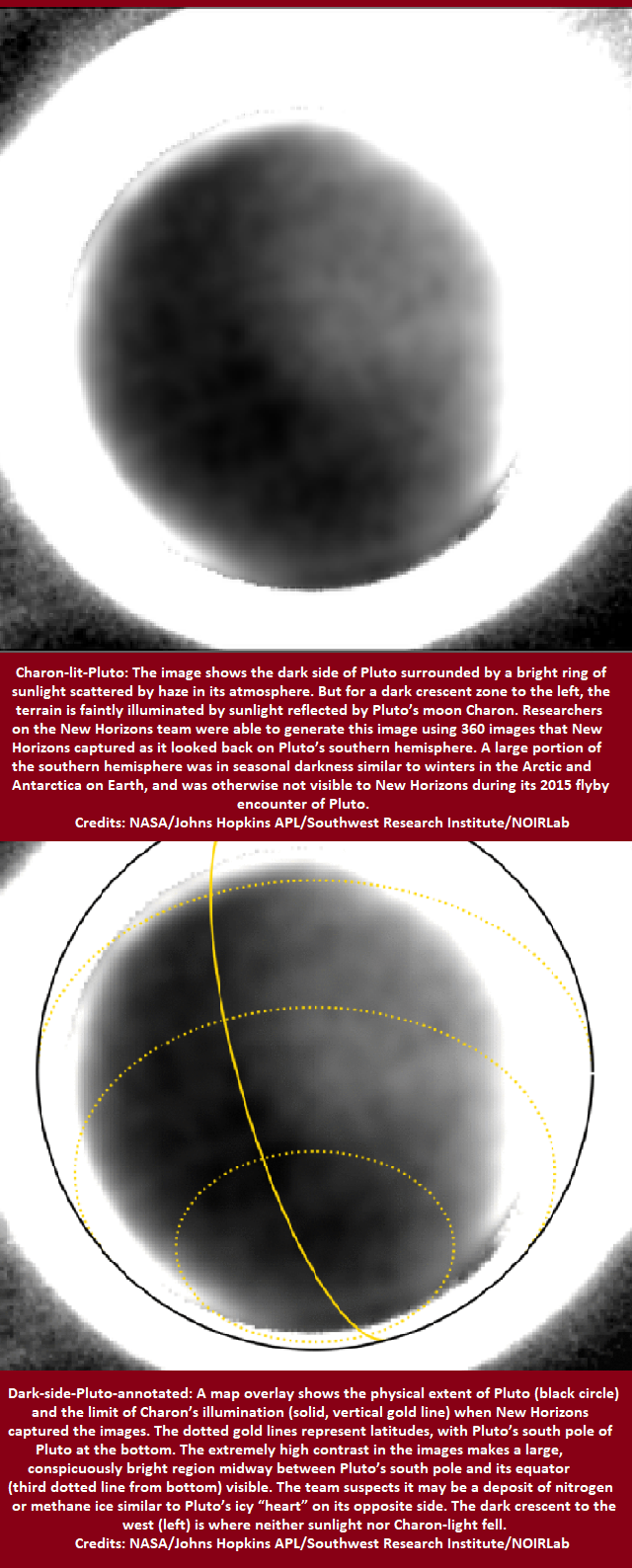NASA’s New Horizons spacecraft made history by returning the first close-up images of Pluto and its moons. Now, through a series of clever methods, researchers led by Tod Lauer of the 'National Science Foundation’s National Optical Infrared Astronomy Research Lab' in Tucson, Arizona, on the New Horizons team have expanded that photo album to include the portion of Pluto’s landscape that wasn’t directly illuminated by sunlight — what the team calls Pluto’s 'dark side'.

Backlit by the distant Sun, Pluto’s hazy atmosphere stood out as a brilliant ring of light encircling the Pluto’s dark side. From its vantage point when this experiment was conducted, New Horizons was mainly able to see Pluto’s southern hemisphere, a large portion of which was transitioning to its winter seasonal darkness — something much like the dark, months-long Arctic and Antarctic winters on Earth, except on Pluto each season lasts 62 Earth years.
Fortunately, a portion of Pluto’s dark southern hemisphere was illuminated by the faint sunlight reflecting off the icy surface of Pluto’s largest moon, Charon, which is about the size of Texas. That bit of “Charon-light” was just enough for researchers to tease out details of Pluto’s southern hemisphere that could not be obtained any other way.
“In a startling coincidence, the amount of light from Charon on Pluto is close to that of the Moon on Earth, at the same phase for each,” said Tod Lauer, an astronomer at the National Science Foundation’s National Optical Infrared Astronomy Research Observatory in Tucson, Arizona, and the study’s lead author. “At the time, the illumination of Charon on Pluto was similar to that from our own Moon on Earth when in its first-quarter phase.”
The researchers published the resulting image and the scientific interpretation of it on Oct. 20 in The Planetary Science Journal.
Recovering details on Pluto’s surface in faint moonlight wasn’t easy. When looking back at Pluto with the New Horizons Long Range Reconnaissance Imager (LORRI), scattered light from the Sun (which was nearly directly behind Pluto) produced a complex pattern of background light that was 1,000 times stronger than the signal produced by Charon-reflected light, according to New Horizons coinvestigator and Project Scientist Hal Weaver, at the Johns Hopkins Applied Physics Laboratory. In addition, the bright ring of atmospheric haze surrounding Pluto was itself heavily over-exposed, producing additional artifacts in the images.
“The problem was a lot like trying to read a street sign through a dirty windshield when driving towards the setting Sun, without a sun visor,” said John Spencer, New Horizons co-investigator and planetary scientist at the Southwest Research Institute in Boulder, Colorado, a study co-author.
It took the combination of 360 images of Pluto’s dark side, and another 360 images taken with the same geometry but without Pluto in the picture, to produce the final image with the artifacts subtracted out leaving only the signal produced by Charon-reflected light.
Alan Stern, the New Horizons principal investigator at the Southwest Research Institute, added that “the image processing work that Tod Lauer led was completely state of the art, and it allowed us to learn some fascinating things about a part of Pluto we otherwise would not have known.”
The resulting map, while still containing digital noise, shows a few prominent features on Pluto’s shadowed surface. The most prominent of these is a dark crescent zone to the west, where neither sunlight nor Charon-light was falling when New Horizons took the images. Also conspicuous is a large, bright region midway between Pluto’s south pole and its equator. The team suspects it may be a deposit of nitrogen or methane ice similar to Pluto’s icy “heart” on its opposite side.
Pluto’s south pole and the region of the surface around it appears to be covered in a dark material, starkly contrasting with the paler surface of Pluto’s northern hemisphere. The researchers suspect that difference could be a consequence of Pluto having recently completed its southern summer (which ended 15 years before the flyby). During the summer, the team suggests that nitrogen and methane ices in the south may have sublimated from the surface, turning directly from solid to vapor, while dark haze-particles settled over the region.
Future Earth-based instruments could eventually verify the team’s image and confirm their other suspicions, but it would require Pluto’s southern hemisphere to be in sunlight — something that won’t happen for nearly 100 years. “The easiest way to confirm our ideas is to send a follow-on mission,” Lauer said.
The Johns Hopkins University Applied Physics Laboratory in Laurel, Maryland, designed, built and operates the New Horizons spacecraft, and manages the mission for NASA's Science Mission Directorate. The MSFC Planetary Management Office provides the NASA oversight for the New Horizons. Southwest Research Institute, based in San Antonio, directs the mission via Principal Investigator Stern, and leads the science team, payload operations and encounter science planning. New Horizons is part of the New Frontiers Program managed by NASA's Marshall Space Flight Center in Huntsville, Alabama.
Source: Nasa.gov
Op zoek naar een specifief product, therapeut, organisatie, winkel of praktijk? Klik dan op deze link! (nog in opbouw)

"Vind mensen, die in zichzelf zowel de motivatie als de aangeboren drijfveer hebben om aan hun Innerlijke Zelf te werken, en we zullen hen gidsen."
- DIMschool vzw, de énige gespecialiseerd in Zelfkennis, zijnde: het kennen van het Zelf -
--------------------------------------------------------------------------------------------------------------------------------------------------
Voel je je geroepen om Spiritualia te sponsoren?
Klik hier en, alvast bedankt!
Overschrijven kan ook via: IBAN: BE22 7795 9845 2547 - BIC: GKCCBEBB
- Ook kan je in onze webshop iets aankopen, waaronder:
Archetypen vragenlijst
Kristallen schedels
Pendels
Purperen plaatjes
Wierook & Benodigdheden
Voor de 'Zoekers naar hun Innerlijke Waarheid' is er...: Eclecticus!
En, dan heb je nog de vaste teksten...
DIMschool biedt 10 interessante privé-sessies aan waaruit jij kan kiezen!
Dossier Zelfkennis: Over de Handleiding Pendelen van A tot Z
'Eclecticus': een korte introductie…
Meteorieten zijn hoogstwaarschijnlijk zo oud als onze planeet: eentje kopen?
Prachtige geode amethist schedel van 4 kg 340 gram zoekt een warme thuis.
Wat is jouw Archetype ? En, ken je ook die van jouw partner?